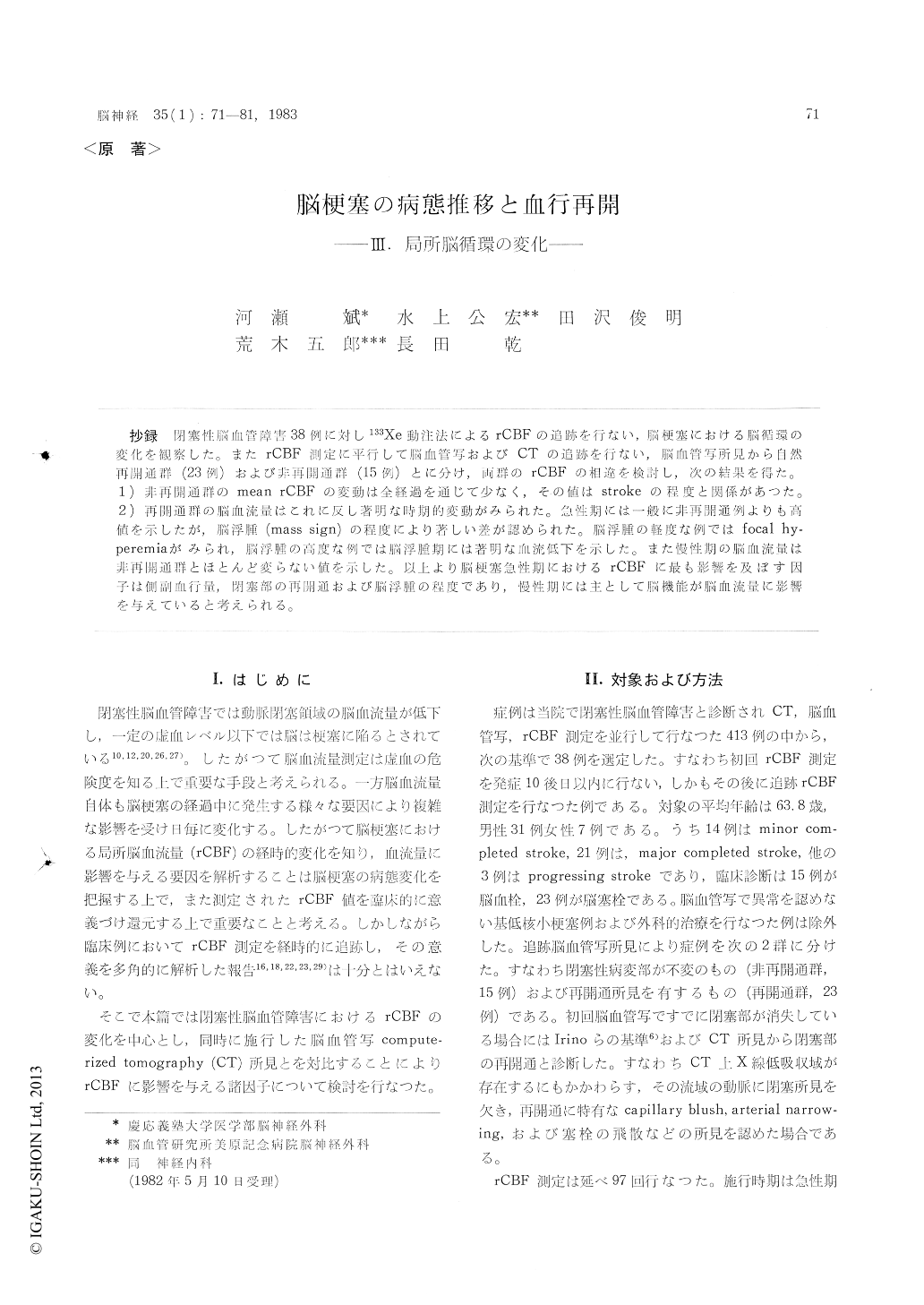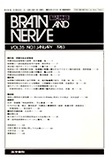Japanese
English
- 有料閲覧
- Abstract 文献概要
- 1ページ目 Look Inside
抄録 閉塞性脳血管障害38例に対し133Xe動注法によるrCBFの追跡を行ない,脳梗塞における脳循環の変化を観察した。またrCBF測定に平行して脳血管写およびCTの追跡を行ない,脳血管写所見から目然再開通群(23例)および非再開通群(15例)とに分け,両群のrCBFの相違を検討し,次の結果を得た。1)非再開通群のmean rCBFの変動は全経過を通じて少なく,その値はstrokeの程度と関係があつた。2)再開通群の脳血流量はこれに反し著明な時期的変動がみられた。急性期には一般に非再開通例よりも高値を示したが,脳浮腫(mass sign)の程度により署しい差が認められた。脳浮腫の軽度な例ではfocal hy—peremiaがみられ,脳浮腫の高度な例では脳浮腫期には著明な血流低下を示した。また慢性期の脳性流量は非再開通群とほとんど変らない値を示した。以上より脳梗塞急性期におけるrCBFに最も影響を及ぼす因子は側副血行量,閉塞部の再開通および脳浮腫の程度であり,慢性期には主として脳機能が脳血流血に影響を与えていると考えられる。
Thirty-eight patients with occlusive cerebrovas-cular disease were followed with regional cerebral blood flow (rCBF) measurement, angiography and computerized tomography (CT) to know the time course of rCBF in cerebral infarction. The rCBF study was carried out by the 133Xe intracarotid injection method with 16 scintillation detectors. They were allocated to two groups according to the findings on angiograms ; 15 patients having any change of occlusive lesion (the group of no-recanalization) and 23 patients showing reopening of occluded vessels (the group of recanalization). A mass sign and an extent of cerebral infarction were observed on CT.
In the group of no-recanalization, a mean value of rCBF (mean rCBF) in acute stage was well correlated to the severity of ischemic stroke. In minor completed strokes the average mean rCBF was 35.8±3.7ml/100g/min, which is significantly higher than that in major strokes and progress-ing strokes of 24.8±3.9 ml/100g/min (p<0.001). Sequential change of mean rCBF was not promi-nent in the group of no-recanalization. However, rCBF change was conspiculous in the group of recanalization. In acute stage of recanalization, rCBF were markedly affected by the presence of mass sign (cerebral edema) on CT. When CT showed midline shift of structure, mean rCBF was markedly reduced, and when without midline shift, focal hyperemic areas were sometimes observed in the revascularized area. Thus, the inhomogeneity of rCBF was characteristic in cases with recanalization. The focal hyperemia usually disappeared within one week in cases of minor stroke and lasted until 2 or 3 weeks in cases of major stroke. In chronic stage, mean rCBF de-creased, and there was no significant difference of averaged rCBF between two groups.
Those findings suggests that the main factor influenced on the sequential change of rCBF is re-opening of occluded vessels. Regional CBF may depends both on the degree of cerebral edema and the extent of vasoparesis after revasculariza tion. In chronic stage CBF value is not always dependent to the presence of occlusive lesion but might be reflected in the total brain function.

Copyright © 1983, Igaku-Shoin Ltd. All rights reserved.


